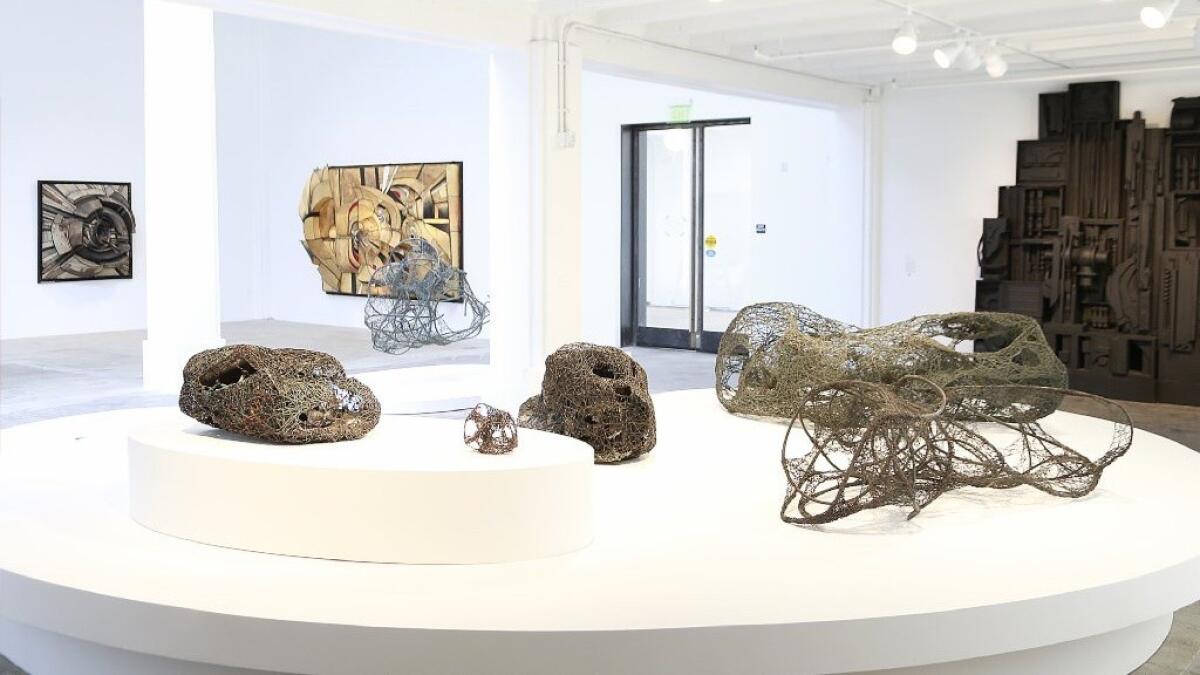Claire Falkenstein’s strangely contradictory sculptures
In the 1960s, Claire Falkenstein was the go-to artist for monumental abstract sculpture commissions in Los Angeles. She also made prominent outdoor sculptures for civic spaces in California cities stretching from the Central Valley to the Mexican border.
An enormous fountain animated the front of a prominent Wilshire Boulevard bank, its tall intertwined tangle of copper tubing and chunks of colored glass reaching 45 feet long and 30 feet wide at the edge of the Miracle Mile, just a few blocks east of the spanking-new Los Angeles County Museum of Art.
A trio of sheet metal sculptures unfurled at Fulton Mall, an architecturally adventurous, award-winning design for a pedestrian promenade in Fresno.
Outdoor sculptures were built for reflecting pools at Cal State Long Beach and the San Diego Museum of Art and as ornamentation over the entry to a new physical education building at Cal State Fullerton. Another vibrant fountain landed at the Long Beach Museum of Art.
Perhaps the crowning achievement was a mammoth commission from the Archdiocese of Los Angeles. Eight bronze doors and 15 three-dimensional stained-glass windows — each 80 feet tall, with one soaring to a height of 130 feet up the side of a massive steeple — grace a Roman Catholic church. The starkly contemporary house of worship, a Modernist design in the heart of what is now Koreatown, is just across the side street from the extravagant Wilshire Boulevard Temple, a traditional architectural treasure that dates to Hollywood’s meteoric rise in the 1920s.
Many of Falkenstein’s abstract sculptures were tied to innovative new buildings by prominent 1960s architects and landscape designers, including Charles Luckman, A.C. Martin, Garrett Eckbo and Victor Gruen Associates. The projects reflect the state’s ambitious institutional expansiveness, from the development of its widely admired system of higher education to the rapid growth of its museum culture.
That such prominent sculpture commissions went to a woman in an overwhelmingly male art world is a sign of a certain progressive singularity. Likewise, all that energetic activity represented the beginnings of an irreversible shift in California’s center of artistic gravity. Once centered in San Francisco, it steadily turned toward L.A.
Given all this, a puzzlement presents itself. Why is Falkenstein’s art so little-known today?
Modest examples of her sculpture, as well as prints and jewelry designs, turn up now and again in local auctions. Yet, just one significant example is in the collection of a major Los Angeles museum — and it entered through the back door. In 1970, UCLA’s Franklin D. Murphy Sculpture Garden, now overseen by the Hammer Museum, acquired a large, spiky sphere assembled from curved and pinched copper tubes, joining the lengthy list of outdoor public venues for her work.
Neither LACMA nor the Museum of Contemporary Art has a Falkenstein sculpture. (LACMA does have a 1942 Cubist-Surrealist painting, plus a 1972 embossed print.) Five years ago, when the Getty Museum surveyed L.A.’s innovative art from 1950 to 1970 for “Pacific Standard Time,” Falkenstein didn’t make the cut.
History hasn’t been kind to her work. One reason, I think, is the unusual position Falkenstein occupies: She stands at a crossroads where the city’s embryonic cultural maturity met the larger evolution of art.
Her best sculptures consolidated ideas in European Modernism that had already developed in the first half of the 20th century. Their large-scale efflorescence in 1960s L.A. represents the end of something — albeit in a time and place defined by a rambunctious sense of new beginnings.
That’s a complicated knot, nearly as tangled as the enormous pile of intertwined copper tubes in “Structure and Flow No. 2,” the mammoth Wilshire Boulevard fountain. It was destroyed nearly 25 years ago. (Falkenstein told an interviewer that vandals working in the dead of night cut it up and sold big sections of the valuable copper for scrap. The story sounds improbable, but what actually happened remains a mystery.) Right now, however, we have a good opportunity to sort out that complication. Falkenstein is having something of a moment.
The career of the late artist, who died in 1997 at age 89, is the subject of an overview exhibition of 57 works at the Pasadena Museum of California Art, which specializes in the less-studied nooks and crannies of 20th century West Coast art. The modest show, organized by guest curator Jay Belloli and largely selected from holdings in the artist’s foundation, includes student efforts, late paintings, a few ceramics, some wood carvings, jewelry designs, two glass vases, a Surrealist abstraction carved in low-relief on the back of an illuminated plexiglass sheet and more than a dozen prints.
The aim of such range is to emphasize experimentation. The sculptor’s show is subtitled “Beyond Sculpture,” and the diversity of mediums and materials is in keeping with classic Modernism’s exploratory sensibility.
Fifteen discrete object-sculptures are on view. The most eccentric is a 1963-64 tangle of wire, painted half black and half white, encasing an abandoned grocery-store shopping cart. The two halves are hinged, capable of opening and closing like a giant jaw. Titled “Predator,” it looks like some monstrous chrysalis from the Black Lagoon — a post-apocalyptic urban tumbleweed swallowing a suburban Giacometti chariot.
Another seven examples of Falkenstein’s gnarled sculptures, these made from twisted metal and colored glass, are included in “Revolution in the Making: Abstract Sculpture by Women, 1947-2016.” The impressive show inaugurates the Hauser Wirth & Schimmel gallery downtown.
Here Falkenstein is in the company of such contemporaneous American superstars as Louise Bourgeois, Lee Bontecou, Louise Nevelson and Eva Hesse. The cocoon sculptures, ancestors of “Predator,” were made between 1954 and 1962, when Falkenstein lived and worked in Europe, principally in Paris but part-time in Venice, Italy. Her 13 years abroad saw her sculpture reach its mature phase.
Falkenstein was born in the isolated fishing town of Coos Bay, Ore., in 1908. When she was 12, her family moved to San Francisco, and she lived in the Bay Area for the next 30 years — studying art at UC Berkeley and then teaching at Mills College and the San Francisco Art Institute.
Her cohorts included Eastern European Modernist emigres Alexander Archipenko, György Kepes and László Moholy-Nagy, avant-garde sculptors who pioneered experimentation with materials from industrial metal to plastic, and with structures informed by scientific theory. She befriended painter Clyfford Still, whose commitment to abstraction fit their Bauhaus-inflected idea of art as a potentially universal language.
Falkenstein was in her element.
Her own work didn’t really blossom, though, until she packed up and moved to Paris in 1950. She was 42. A late bloomer, she embraced an established School of Paris milieu that included sculptors Jean Arp, Constantin Brancusi and Alberto Giacometti. Critic Michel Tapié championed her work as Art informel, a refined European variation of rough-hewn Abstract Expressionism.

One irony of Falkenstein’s concurrent exhibitions is that the concentrated gallery show is more powerful than the wide-ranging museum show. The gallery’s seven works are examples of 1950s sculptures she called “Suns,” wire thickets twisted around curved metal armatures. (One 1961 version is in the Pasadena survey.) Sometimes, chunks of colored glass are embedded within.
Rather than a conventional sculptural interest in mass, Falkenstein’s organic forms articulate dynamic space. Transparency, color and light are enmeshed within linear webs of extruded wire. Those webs create an arduous three-dimensional drawing in space, where compacted energy is materialized.
They also formed the basis for a crucial commission. In 1961, Falkenstein designed the entrance gates to art collector Peggy Guggenheim’s famed palazzo on the Grand Canal in Venice. The doorway is a planar web of iron punctuated by big chunks of colored Murano glass, its lattice dense for reasons of security.
Guggenheim’s lustrous pedigree was no doubt critical when Falkenstein moved back to California two years later, settling into a small beachside studio in the “other” Venice. Richard Brown, LACMA’s director, recommended her for the ill-fated fountain commission just down the street from his new museum. Others soon followed.
The institutional commissions are a strange hybrid, both avant-garde and conservative. Modern sculpture, rather than a mythological figure or a bronze hero on a horse, was in keeping with the city’s evolving self-image as herald of the future. Yet, Falkenstein’s art represented a safely European Modernist ideal; artistically speaking, it was on its way out.
The tension between future and past found its epitome in the huge commission for St. Basil Catholic Church, dedicated in 1969. Rather than the usual Spanish Revival or Mediterranean style, architects at A.C. Martin designed an imposing Modernist fortress. An ancient Christian motif of the church as a bulwark and refuge was reconfigured as a faceted concrete wall assembled from a dozen geometric towers with shafts of space between them. Falkenstein filled the spaces with tall, modular windows in faceted stained glass.
They are totally abstract, virtually unprecedented for a church. But the pure abstraction of the full-height windows is not without symbolism.
There are 12, one per apostle, with the 13th rising up the steeple to the cross. Triangular bronze frames represent the Catholic doctrine of the Trinity, while the structural pattern is infinitely expandable. The Passion is brought into the present by a loose progression of colors from mostly cool at the rear of the nave to mostly warm near the altar, with its 14th century Tuscan crucifix. If the play of dappled color across interior concrete surfaces isn’t as intense as one might hope, even on a sunny day, the aesthetic ambition is evident.
Artistically, so is its conservatism. As a concept, St. Basil’s design fulfilled the aim of the Second Vatican Council, the mid-1960s push to emphasize the institutional church’s openness to operating in the contemporary realm. Ironically, while Vatican II was revolutionary, Falkenstein’s art represents the assured finale of an established European Modernism.
In L.A., radical artistic transformation was underway. Robert Irwin was dismantling hardwired perceptions of light and space, Judy Chicago was making ephemeral sculptures out of fireworks and smoke, John Baldessari was cremating exhausted abstract paintings and the artist collective ASCO was on the brink of appropriating crude Chicano stereotypes to destabilize establishment power. Falkenstein’s sculptures bumped up against the bracing uncertainty of sweeping new beginnings, which soon overtook her work.
‘Claire Falkenstein: Beyond Sculpture’
Where: Pasadena Museum of California Art, 490 E. Union St., Pasadena
When: Wednesdays through Sundays, through Sept. 11
Info: https://pmcaonline.org/
ALSO:
Alison Saar traces diasporas in the exceptional ‘Silt, Soot and Smut’ at L.A. Louver Gallery
Art as a mirror of selfie culture? That’s ‘Cindy Sherman: Imitation of Life’
Heinous history as potent muse in Underground Museum’s ‘Non-fiction’
Follow me @KnightLAT
More to Read
The biggest entertainment stories
Get our big stories about Hollywood, film, television, music, arts, culture and more right in your inbox as soon as they publish.
You may occasionally receive promotional content from the Los Angeles Times.











